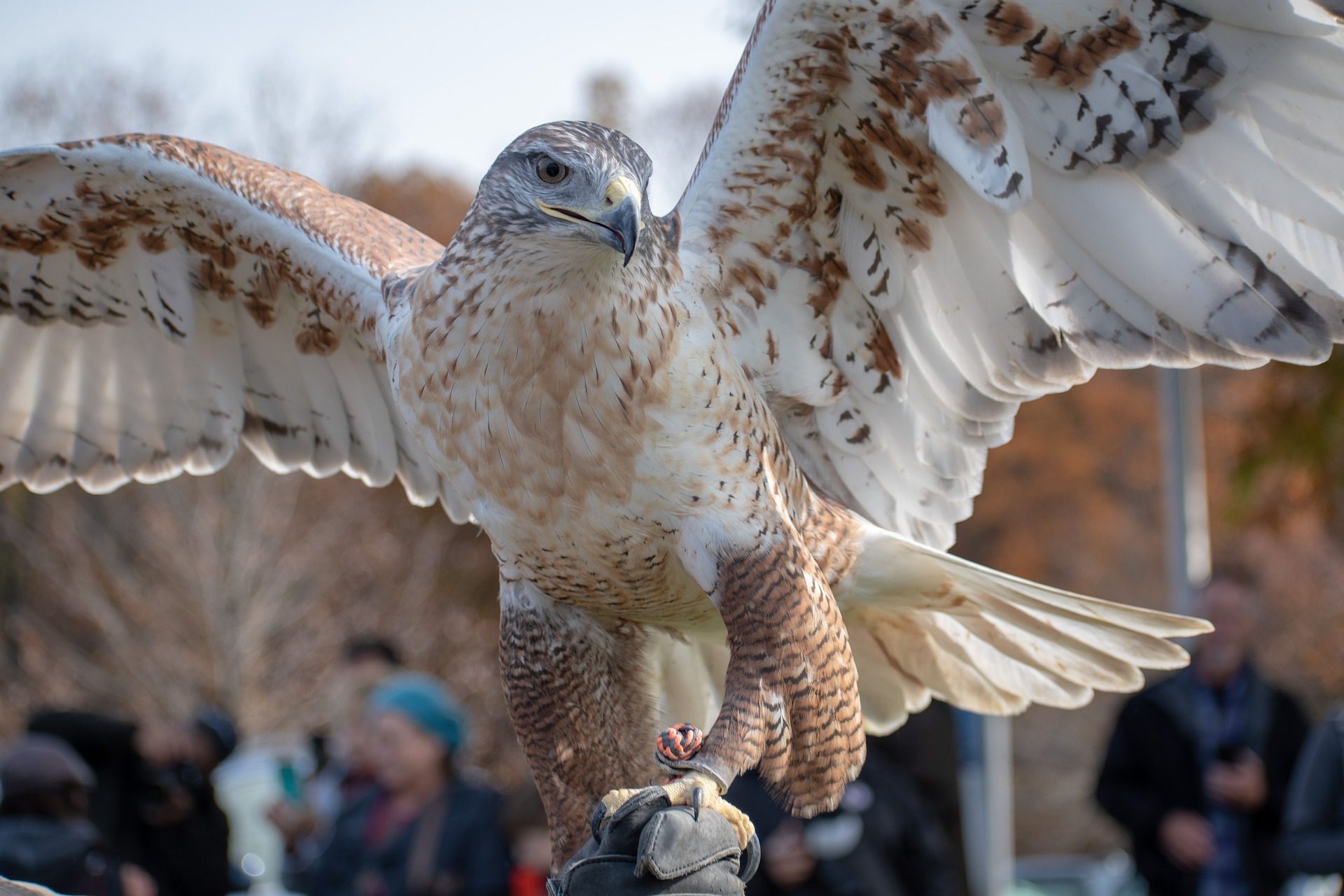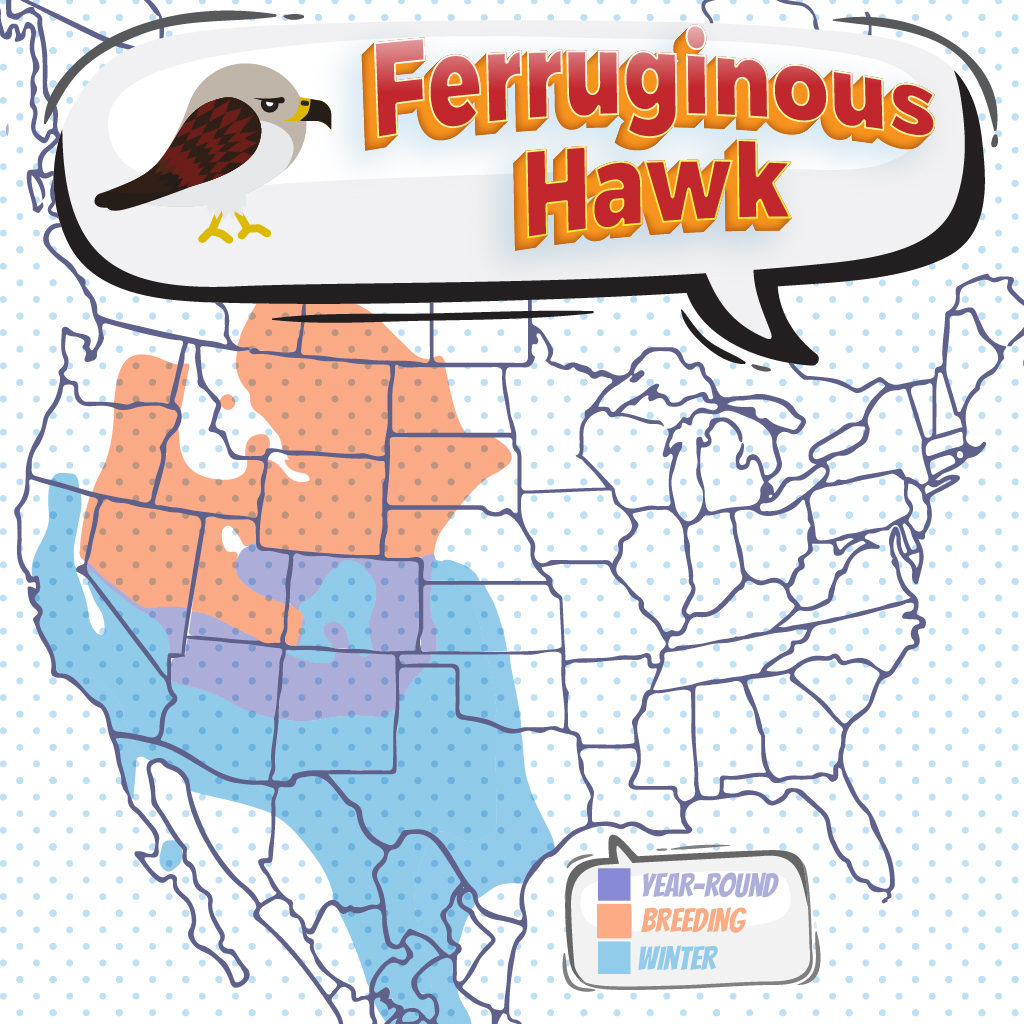
Ferruginous Hawk
A Ferruginous Hawk is a fun bird to see while bird watching. Below are some tips to help you identify Ferruginous Hawks. We have also put together a list of fun Ferruginous Hawk t-shirts, Ferruginous Hawk bird patches, birdhouses, bird feeders, binoculars, stickers, and other fun bird-watching items.
About Ferruginous Hawks
Ferruginous Hawks are found in deserts and open range because of their preferred hunting style from a lone tree, cliffs, or high up in the sky. It is the largest hawk to grace the North American sky. Ferruginous hawks eat small mammals sometimes standing over their entry holes and wait for the prey to pop out.
Description and Identification
Ferruginous Hawks are often mistaken for Eagles due to their proportion and characteristics.
Adult Ferruginous Hawks have long, and broad wings accompanied by a broad tail, ranging in
colors of gray, rust, and white. Their legs are feathered till the talons. Like several birds of prey,
the females of this species are larger than the males. This species has a wingspan ranging from
48-60 inches with an average wingspan of 55 inches. They vary in length from 20-27 inches and
weigh between 32-80 oz. In terms of physical appearances, they can be divided into two
categories: light-morphs and dark morphs. The light-morphs of this species have rusty plumage
with pale heads and necks and underparts. The upper wings are gray in color. The dark
morphs have dark brown plumage with lighter shades on the upper and lower parts of the
wings.
Ferruginous Hawk Color Pattern
Unique with its species it has a gray head, rusty brown shoulders and legs, and flashing white underlying parts. Their upper body parts are rusty brown, and while they soar into the sky their legs form a “V” shape. Rare morphs of these hawks are dark brown almost chocolate.
Ferruginous Hawk Size
Ferruginous hawks are large birds with large heads and relatively long wings. Both sexes have average measurements as follows:
- Length 56 – 69 cm
- Weight 977 – 2074 cm
- Wingspan 133 – 142 cm

Ferruginous Hawk Behavior
They are found alone or in pairs and in the winter, they hunt in close range of each other. They roost on cliffs and pairs may be together year-round with a few exceptions where three adults have been observed in the same nest. During courtship, the pair soars into the sky performing “sky dances” where they do stead dives and ascend. They may grab onto each other’s beaks and talons as they spiral towards the ground. During the breeding season, they are aggressive attacking intruders with open talons.
What Ferruginous Hawk Eat
Their prey mainly consists of small to medium-sized mammals such as rats, mice, various
species of squirrels, hares, etc. but they are also known to feed on reptiles and other birds from
time to time. These include snakes, grasshoppers, crickets, owls, larks, ducks, pheasants, etc.
They fly over open lands in search of prey and are also known to hide and wait outside the
prey’s habitat. They follow a bimodal pattern of hunting, where they hunt in early mornings and
late afternoons.
Their diet is limited to small mammals like rabbits, hares, and ground squirrels. The western ferruginous hawks divide their diets and occasionally include reptiles, amphibians, and birds.
Where Ferruginous Hawks Live
Ferruginous Hawks are sensitive to human presence and therefore prefer the open countryside,
grasslands, and plateaus devoid of trees. They often abandon nests and territories if
encroached upon by humans. During the nesting season, nests are built in open areas or trees.
Their winter habitat is similar to that of the summer, avoiding areas populated by humans and
preferring open grasslands or plateaus.
Ferruginous hawks are grassland and open country birds with their breeding habitats in cliffs and tree groves. They spend the winter in deserts abundant in hares and rabbits.
Range and Migration

Ferruginous Hawks are native to North America. They usually reside in the interior parts of
North America, with habitats ranging from South-Western Canada, Western United States and
Northern Mexico. Their year-long habitats are concentrated in and around the states of Utah,
Colorado, New Mexico, and Arizona in the United States, with nesting around the Northern parts.
They are known to winter in Western, South-Western, and Southern parts of North America
along with some parts of northern Mexico. They migrate short to medium distances. Ferruginous
Hawks in the Alberta to Texas regions tend to first move in the South-East direction and then to
the South, following the grasslands. Certain populations that nest in the South are known to be
sedentary.
Ferruginous Hawk Lifecycle
Ferruginous male and female hawks chose a nesting site together and build the nest together with the male searching for most of the material and the female doing the construction. Nest materials include twigs, sticks and metal debris. The female lays an average of 8 eggs and on a minimum of 1 per breeding season. She incubates the eggs for 32 to 3 days. It takes at least 38 days for the chicks to be strong enough to fly out of the nest.
Ferruginous Hawk Nesting
During the breeding period cultivated fields and modified grasslands are avoided as locations
for nests, open areas, trees, and swamp oaks near waterbodies are preferred for the same,
though the presence of water near the nest is non-critical. They maintain minimum distances
from other nesting raptors, and nests facing different hunting territories are tolerated better as
compared to nests facing the same hunting territories. Courtship and copulation occur during
and after the nest-building period and carry on until the laying of eggs. Nesting period typically
lasts between 38-50 days.
Ornithology
Bird Watching Academy & Camp Subscription Boxes
At Bird Watching Academy & Camp we help kids, youth, and adults get excited and involved in bird watching. We have several monthly subscription boxes that you can subscribe to. Our monthly subscription boxes help kids, youth, and adults learn about birds, bird watching, and bird conservation.
Bird Watching Binoculars for Identifying Ferruginous Hawks
The most common types of bird-watching binoculars for viewing Ferruginous Hawks are 8×21 binoculars and 10×42 binoculars. Bird Watching Academy & Camp sells really nice 8×21 binoculars and 10×42 binoculars. You can view and purchase them here.
Ferruginous Hawk T-shirts
If you love the Ferruginous Hawk you should purchase a Bird Watching Academy & Camp T-shirt. To help support bird conservation we donate 10 percent to bird conservation activities.
Ferruginous Hawk Iron On Patches
Kids, Youth, and Adults love to collect our Bird Watching Academy & Camp iron-on patches. Our bird-watching patches help you keep track of the birds you have seen and identified. You can also display the patches on our Bird Watching Academy & Camp banners.
The Ferruginous Hawk is a great iron-on patch to start your collection with. The patches are durable and can be sewn on or ironed on to just about anything.
Ferruginous Hawk Stickers
Stickers are a great way for you to display your love for bird watching and the Ferruginous Hawk. We sell a monthly subscription sticker pack. The sticker packs have 12 bird stickers. These sticker packs will help your kids learn new birds every month.
Bird Feeders For Ferruginous Hawk
There are many types of bird feeders. Here are our favorite bird feeders for your backyard. We use all of these bird feeders currently. Kids will have a great time watching birds eat at these bird feeders. Using this collection of bird feeders will provide a wide variety and many types of birds.
Best Bird Houses for Ferruginous Hawk
There are many types of birdhouses. Building a birdhouse is always fun but can be frustrating. These 4 birdhouses have become our favorites. Getting a birdhouse for kids to watch birds grow is always fun. We spent a little extra money on these birdhouses but they have been worth the higher price and look great.











